Tooltip in WinUI Chart
31 May 202219 minutes to read
The Tooltip feature allows you to display any information over a ChartSeries. It appears at the data point position when the mouse hovers over any chart segment. It is set to display the metadata of the particular segment or data point.
Define Tooltip
By default, a small box containing the data points y values is displayed as the tooltip. The y values vary depending on the ChartSeries. For example, a single y value is usually displayed in Column and BarSeries.
The tooltip will be visible if you enable ShowTooltip property, as shown in the following code sample.
<syncfusion:ColumnSeries ShowTooltip="True"
ItemsSource="{Binding Demands}"
XBindingPath="Demand" YBindingPath="Year2010"/>
<syncfusion:ColumnSeries ItemsSource="{Binding Demands}"
ShowTooltip="True"
XBindingPath="Demand" YBindingPath="Year2011"/>ColumnSeries series1 = new ColumnSeries()
{
ItemsSource = new ViewModel().Demands,
XBindingPath = "Demand",
YBindingPath = "Year2010",
ShowTooltip = true
};
ColumnSeries series2 = new ColumnSeries()
{
ItemsSource = new ViewModel().Demands,
XBindingPath = "Demand",
YBindingPath = "Year2011",
ShowTooltip = true
};
chart.Series.Add(series1);
chart.Series.Add(series2);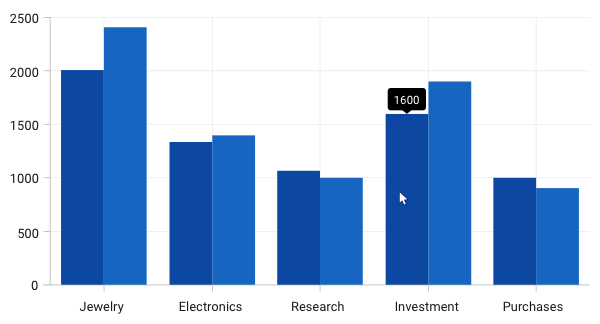
Customizing tooltip using ChartTooltipBehavior
The ChartTooltipBehavior is commonly used for all series to customize the tooltip. For customizing the tooltip, you can create an instance ChartTooltipBehavior and add it to the SfChart Behaviors collection.
The following properties are used to customize and configure tooltip, which is available in the ChartTooltipBehavior.
-
EnableAnimation- Used to enable the animation when showing the tooltip. -
Style- Used to customize the fill and stroke of the tooltip. -
LabelStyle- Used to customize the tooltip label. -
HorizontalOffset- Used to position the tooltip at a distance from the data point or cursor position horizontally. -
VerticalOffset- Used to position the tooltip at a distance from the data point or cursor position vertically. -
HorizontalAlignment- Used to align the tooltip label at left, right, and center of the data point position or cursor position horizontally. -
VerticalAlignment- Used to align the tooltip label at top, center, and bottom of the data point position or cursor position vertically. -
ShowDuration- Used to set the amount of time that the tooltip remains visible in milliseconds. -
InitialShowDelay- Used to delay in milliseconds to show the tooltip once the user interacts with series.
<chart:SfChart.Behaviors>
<chart:ChartTooltipBehavior/>
</chart:SfChart.Behaviors>SfChart chart = new SfChart();
ChartTooltipBehavior behavior = new ChartTooltipBehavior();
chart.Behaviors.Add(behavior);Customizing the tooltip background
The tooltip’s fill and stroke color can be customized using the Style property. To define a Style for tooltip, specify the style of TargetType as Path.
The following code example explains how to apply the style for tooltip.
<chart:SfChart.Resources>
<Style TargetType="Path" x:Key="style">
<Setter Property="Stroke" Value="Gray"/>
<Setter Property="Fill" Value="Black"/>
</Style>
</chart:SfChart.Resources>
...
<chart:SfChart.Behaviors>
<chart:ChartTooltipBehavior LabelStyle = {StaticResource style}/>
</chart:SfChart.Behaviors>SfChart chart = new SfChart();
Style style = new Style(typeof(Path));
style.Setters.Add(new Setter(Path.StrokeProperty, new SolidColorBrush(Colors.Gray)));
style.Setters.Add(new Setter(Path.FillProperty, new SolidColorBrush(Colors.Black)));
...
ChartTooltipBehavior tooltipBehavior = new ChartTooltipBehavior();
tooltipBehavior.Style = style;
chart.Behaviors.Add(tooltipBehavior);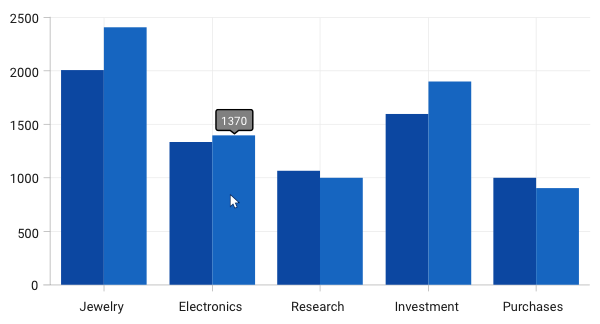
Customizing the tooltip label style
The tooltip label style can be customized using the LabelStyle property. To define a Style for the tooltip label, specify the style of TargetType as TextBlock.
The following code example explains how to apply the style for a tooltip label.
<chart:SfChart.Resources>
<Style TargetType="TextBlock" x:Key="labelStyle">
<Setter Property="FontSize" Value="14"/>
<Setter Property="Foreground" Value="Red"/>
</Style>
</chart:SfChart.Resources>
...
<chart:SfChart.Behaviors>
<chart:ChartTooltipBehavior LabelStyle = {StaticResource labelStyle}/>
</chart:SfChart.Behaviors>SfChart chart = new SfChart();
Style labelStyle = new Style(typeof(TextBlock));
labelStyle.Setters.Add(new Setter(TextBlock.FontSizeProperty, 14d));
labelStyle.Setters.Add(new Setter(TextBlock.ForegroundProperty, new SolidColorBrush(Colors.Red)));
...
ChartTooltipBehavior tooltipBehavior = new ChartTooltipBehavior();
tooltipBehavior.LabelStyle = labelStyle;
chart.Behaviors.Add(tooltipBehavior);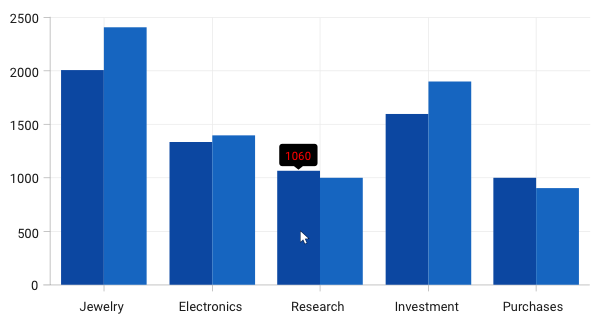
Customizing tooltip using ChartTooltip attached properties
Aligning the tooltip
The tooltip can be aligned with respect to the cursor position using the HorizontalAlignment and VerticalAlignment properties.
HorizontalAlignment
The following code example explains the positioning of tooltip to the left of the cursor.
<Chart:ColumnSeries ShowTooltip="True" ItemsSource="{Binding Demands}"
Chart:ChartTooltip.HorizontalAlignment="Left"
XBindingPath="Demand" YBindingPath="Year2010" />
<Chart:ColumnSeries ItemsSource="{Binding Demands}"
Chart:ChartTooltip.HorizontalAlignment="Left" ShowTooltip="True"
XBindingPath="Demand" YBindingPath="Year2011"/>ColumnSeries series1 = new ColumnSeries()
{
ItemsSource = new ViewModel().Demands,
XBindingPath = "Demand",
YBindingPath = "Year2010",
ShowTooltip = true
};
ChartTooltip.SetHorizontalAlignment(series1, HorizontalAlignment.Left);
ColumnSeries series2 = new ColumnSeries()
{
ItemsSource = new ViewModel().Demands,
XBindingPath = "Demand",
YBindingPath = "Year2011",
ShowTooltip = true
};
ChartTooltip.SetHorizontalAlignment(series2, HorizontalAlignment.Left);
chart.Series.Add(series1);
chart.Series.Add(series2);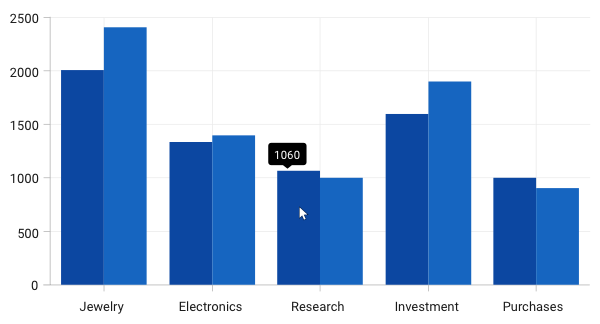
NOTE
By default, the horizontal alignment is center for the tooltip.
VerticalAlignment
The following code example explains the positioning of tooltip to the bottom of the cursor.
<Chart:ColumnSeries ShowTooltip="True" ItemsSource="{Binding Demands}"
Chart:ChartTooltip.VerticalAlignment="Bottom"
XBindingPath="Demand" YBindingPath="Year2010" />
<Chart:ColumnSeries ItemsSource="{Binding Demands}"
Chart:ChartTooltip.VerticalAlignment="Bottom"
ShowTooltip="True" XBindingPath="Demand" YBindingPath="Year2011"/>ColumnSeries series1 = new ColumnSeries()
{
ItemsSource = new ViewModel().Demands,
XBindingPath = "Demand",
YBindingPath = "Year2010",
ShowTooltip = true
};
ChartTooltip.SetVerticalAlignment(series1, VerticalAlignment.Bottom);
ColumnSeries series2 = new ColumnSeries()
{
ItemsSource = new ViewModel().Demands,
XBindingPath = "Demand",
YBindingPath = "Year2011",
ShowTooltip = true
};
ChartTooltip.SetVerticalAlignment(series2, VerticalAlignment.Bottom);
chart.Series.Add(series1);
chart.Series.Add(series2);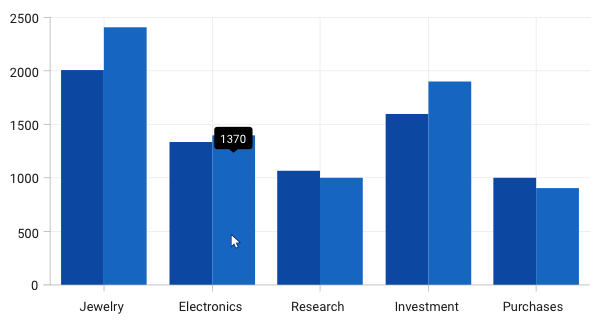
TooltipMargin
You can also set the distance for the margin to be positioned from the cursor using the TooltipMargin property, as shown in the following code sample.
<Chart:ColumnSeries Label="2010" ShowTooltip="True"
ItemsSource="{Binding Demands}"
Chart:ChartTooltip.TooltipMargin="25"
XBindingPath="Demand" YBindingPath="Year2010" />
<Chart:ColumnSeries Label="2011" ItemsSource="{Binding Demands}"
Chart:ChartTooltip.TooltipMargin="25"
ShowTooltip="True" XBindingPath="Demand" YBindingPath="Year2011"/>ColumnSeries series1 = new ColumnSeries()
{
ItemsSource = new ViewModel().Demands,
XBindingPath = "Demand",
YBindingPath = "Year2010",
ShowTooltip = true,
Label = "2010"
};
ChartTooltip.SetTooltipMargin(series1, new Thickness(25));
ColumnSeries series2 = new ColumnSeries()
{
ItemsSource = new ViewModel().Demands,
XBindingPath = "Demand",
YBindingPath = "Year2011",
ShowTooltip = true,
Label = "2011"
};
ChartTooltip.SetTooltipMargin(series2, new Thickness(25));
chart.Series.Add(series1);
chart.Series.Add(series2);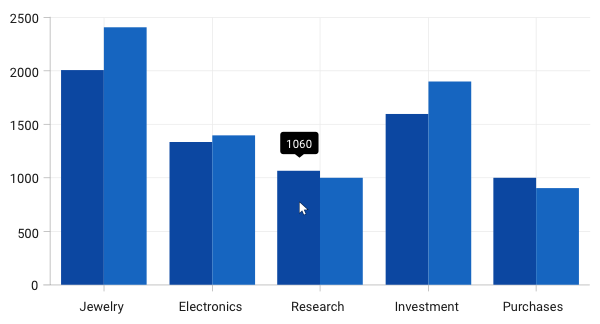
NOTE
By default, the VerticalAlignment of the tooltip is Top.
VerticalOffset and HorizontalOffset
The tooltip can be positioned at a particular distance from the cursor horizontally and vertically using the HorizontalOffset and VerticalOffset properties.
<Chart:ColumnSeries ShowTooltip="True"
ItemsSource="{Binding Demands}"
Chart:ChartTooltip.HorizontalOffset="40"
Chart:ChartTooltip.VerticalOffset="40"
XBindingPath="Demand" YBindingPath="Year2010" />
<Chart:ColumnSeries ItemsSource="{Binding Demands}"
Chart:ChartTooltip.HorizontalOffset="40"
Chart:ChartTooltip.VerticalOffset="40" ShowTooltip="True"
XBindingPath="Demand" YBindingPath="Year2011"/>ColumnSeries series1 = new ColumnSeries()
{
ItemsSource = new ViewModel().Demands,
XBindingPath = "Demand",
YBindingPath = "Year2010",
ShowTooltip = true,
Label = "2010"
};
ChartTooltip.SetHorizontalOffset(series1, 40);
ChartTooltip.SetVerticalOffset(series1, 40);
ColumnSeries series2 = new ColumnSeries()
{
ItemsSource = new ViewModel().Demands,
XBindingPath = "Demand",
YBindingPath = "Year2011",
ShowTooltip = true,
Label = "2011"
};
ChartTooltip.SetHorizontalOffset(series2, 40);
ChartTooltip.SetVerticalOffset(series2, 40);
chart.Series.Add(series1);
chart.Series.Add(series2);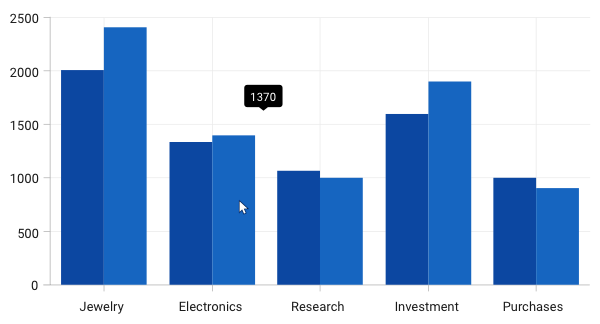
Tooltip duration
The attached property ShowDuration in ChartTooltip sets the duration time for tooltip to be displayed in milliseconds.
The following code example demonstrates the duration of the tooltip set as 5 seconds.
<Chart:ColumnSeries ShowTooltip="True"
Chart:ChartTooltip.ShowDuration="5000"
ItemsSource="{Binding Demands}"
XBindingPath="Demand" YBindingPath="Year2010">
</Chart:ColumnSeries>ColumnSeries series = new ColumnSeries()
{
ItemsSource = new ViewModel().Demands,
XBindingPath = "Demand",
YBindingPath = "Year2010",
ShowTooltip = true,
Label = "2010"
};
ChartTooltip.SetShowDuration(series, 5000);
chart.Series.Add(series);NOTE
By default, the tooltip will be displayed for 1000 milliseconds.
Show delay
The tooltip also has support to delay the time to display by setting the SetInitialShowDelay property in milliseconds.
The following code example demonstrates how the tooltip will be delayed for one second before being displayed.
<Chart:ColumnSeries Label="2010" ShowTooltip="True"
Chart:ChartTooltip.InitialShowDelay="1000"
ItemsSource="{Binding Demands}"
XBindingPath="Demand" YBindingPath="Year2010" />ColumnSeries series = new ColumnSeries()
{
ItemsSource = new ViewModel().Demands,
XBindingPath = "Demand",
YBindingPath = "Year2010",
ShowTooltip = true,
Label = "2010"
};
ChartTooltip.SetInitialShowDelay(series, 1000);
chart.Series.Add(series);Animation for tooltip
You can also provide animation effects for tooltip by setting the EnableAnimation property to true, as shown in the following code sample.
<Chart:ColumnSeries Label="2010" ShowTooltip="True"
Chart:ChartTooltip.EnableAnimation="True"
ItemsSource="{Binding Demands}"
XBindingPath="Demand" YBindingPath="Year2010">
</Chart:ColumnSeries>ColumnSeries series = new ColumnSeries()
{
ItemsSource = new ViewModel().Demands,
XBindingPath = "Demand",
YBindingPath = "Year2010",
ShowTooltip = true,
Label = "2010"
};
ChartTooltip.SetEnableAnimation(series, true);
chart.Series.Add(series);Customizing the appearance
The TooltipTemplate property allows you to customize the default appearance of the tooltip, as shown in the following code sample.
...
<chart:SfChart.Resources>
<DataTemplate x:Key="tooltipTemplate1">
<StackPanel Orientation="Horizontal">
<TextBlock Text="{Binding Item.Demand}"
Foreground="Black" FontWeight="Medium" FontSize="12" HorizontalAlignment="Center" VerticalAlignment="Center"/>
<TextBlock Text=" : " Foreground="Black" FontWeight="Medium" FontSize="12" HorizontalAlignment="Center" VerticalAlignment="Center"/>
<TextBlock Text="{Binding Item.Year2010}"
Foreground="Black" FontWeight="Medium" FontSize="12" HorizontalAlignment="Center" VerticalAlignment="Center"/>
</StackPanel>
</DataTemplate>
<DataTemplate x:Key="tooltipTemplate2">
<StackPanel Orientation="Horizontal">
<TextBlock Text="{Binding Item.Demand}"
Foreground="Black" FontWeight="Medium" FontSize="12" HorizontalAlignment="Center" VerticalAlignment="Center"/>
<TextBlock Text=" : " Foreground="Black" FontWeight="Medium" FontSize="12" HorizontalAlignment="Center" VerticalAlignment="Center"/>
<TextBlock Text="{Binding Item.Year2011}"
Foreground="Black" FontWeight="Medium" FontSize="12" HorizontalAlignment="Center" VerticalAlignment="Center"/>
</StackPanel>
</DataTemplate>
<Style TargetType="Path" x:Key="style">
<Setter Property="Stroke" Value="Black"/>
<Setter Property="Fill" Value="LightGreen"/>
<Setter Property="StrokeThickness" Value="2"/>
</Style>
</chart:SfChart.Resources>
...
<chart:ColumnSeries ShowTooltip="True" ItemsSource="{Binding Demands}"
XBindingPath="Demand" YBindingPath="Year2010"
TooltipTemplate="{StaticResource tooltipTemplate1}">
</chart:ColumnSeries>
<chart:ColumnSeries ItemsSource="{Binding Demands}"
ShowTooltip="True" XBindingPath="Demand" YBindingPath="Year2011"
TooltipTemplate="{StaticResource tooltipTemplate2}">
</chart:ColumnSeries>
...
<chart:SfChart.Behaviors>
<chart:ChartTooltipBehavior Style="{StaticResource style}"/>
</chart:SfChart.Behaviors>
......
ColumnSeries series1 = new ColumnSeries()
{
ItemsSource = Demands,
XBindingPath = "Demand",
YBindingPath = "Year2010",
Label = "2010",
ShowTooltip = true,
TooltipTemplate = chart.Resources["tooltipTemplate1"] as DataTemplate,
};
ColumnSeries series2 = new ColumnSeries()
{
ItemsSource = Demands,
XBindingPath = "Demand",
YBindingPath = "Year2011",
Label = "2011",
ShowTooltip = true,
TooltipTemplate = chart.Resources["tooltipTemplate2"] as DataTemplate,
};
chart.Series.Add(series1);
chart.Series.Add(series2);
...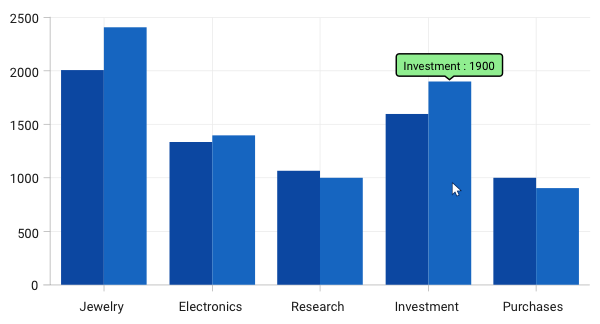
NOTE
The
ChartTooltipBehavioris commonly used for all series to customize the tooltip. If you need to customize the appearance of the tooltip based on a particular series, you can use the attachedChartTooltipproperties in a series. Series attached properties are considered as a high precedence.